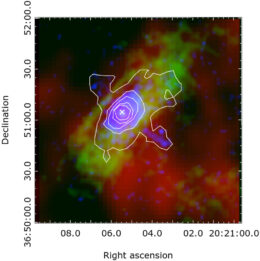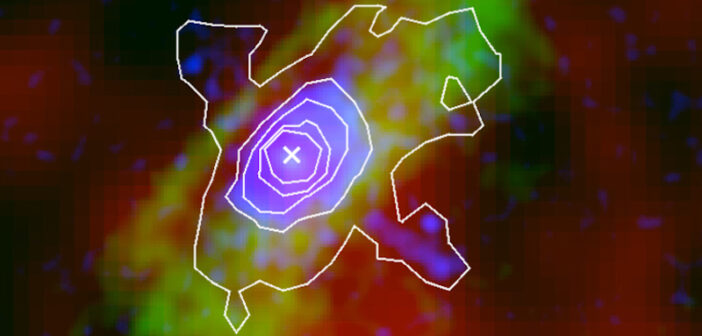Editor’s Note: Astrobites is a graduate-student-run organization that digests astrophysical literature for undergraduate students. As part of the partnership between the AAS and astrobites, we occasionally repost astrobites content here at AAS Nova. We hope you enjoy this post from astrobites; the original can be viewed at astrobites.org.
Title: Hard X-ray Observation and Multiwavelength Study of the PeVatron Candidate Pulsar Wind Nebula “Dragonfly”
Authors: Jooyun Woo et al.
First Author’s Institution: Columbia Astrophysics Laboratory
Status: Published in ApJ
Pulsar Wind Nebulae: Little Space Animals

Figure 1: A multi-wavelength view of the Crab Nebula that shows the X-rays from the pulsar wind nebula (pinkish-white region at the center). [NASA, ESA, NRAO/AUI/NSF and G. Dubner (University of Buenos Aires)]
The Crab Nebula isn’t the only pulsar wind nebula with a fun nickname; in fact, most of these nebulae and their associated supernova remnants are named after animals that they (very) vaguely resemble. There’s the Mouse, the Goose, and the Kookaburra, just to name a few — and of course, the topic of today’s article, the Dragonfly (see Figure 2). Besides slightly resembling animals, pulsar wind nebulae are also thought to produce the highest-energy particles we detect on Earth. A new catalog of the highest-energy gamma-rays ever seen (see this bite) either links or tentatively associates many of these energetic systems with pulsars or pulsar wind nebulae.

Figure 2: Radio (colour) and X-ray (contours) image of the Dragonfly pulsar wind nebula. Doesn’t it sort of look like a dragonfly? [Jin et al. 2023]
Looking for the Dragonfly with All Sorts of Different (Wavelength) Eyes!
The authors of today’s article investigate the Dragonfly with multiple different telescopes that detect light across the electromagnetic spectrum to get a full picture of what’s going on with the particles accelerated in and around the nebula. The authors model the multi-wavelength emission to try to figure out if the Dragonfly is capable of accelerating particles (electrons, protons, and other things) up to petaelectronvolt (PeV; that’s a quadrillion electronvolts!) energies that then interact to make gamma rays, which would classify it as a PeVatron (a name that aptly describes any astronomical source that can accelerate particles up to PeV energies). We detect the highest-energy charged cosmic rays up to PeV energies, but we haven’t seen too many sources that emit gamma rays at these energies due to instrumental limitations and other things like photon absorption. Since cosmic rays (usually protons) get deviated in their travels to Earth by the swirling magnetic fields of the Milky Way, we need to search for neutral particles of similar energies, like photons (i.e., gamma rays) to find PeVatrons, since they trace a straight line back from the particle to its source.
Using model fitting, the authors can create and evolve a pulsar and pulsar wind nebula to match the observed data, which gives them information like the nebular age, the expected shape of the nebula’s emission, and whether or not it can be a PeVatron, among many other interesting clues that help narrow down what’s going on with the particles and material in this system.
In particular, one interesting thing the authors notice is that the shape of the Dragonfly is long and asymmetric in soft X-ray wavelengths (and potentially in other wavelengths, but it’s hard to say due to much coarser angular resolution; see Figure 3b). Usually we’d expect to see a more spherical shape, so the explanation for this could be that the pulsar that’s powering the nebula is zooming through space at an unusually high speed or, more likely, that the nebula lives within a supernova remnant that hasn’t been seen yet. The interaction of particles from the pulsar wind nebula with the supernova remnant can cause some funky shapes to appear in the surrounding material. The authors suggest that looking at the Dragonfly with a long exposure in radio wavelengths might be able to pick up signs of a supernova remnant that are overwhelmed in other wavelengths by the bright pulsar wind nebula to confirm this scenario.

Figure 3: The observed shape of the Dragonfly in a) radio, b) soft X-ray, c) hard X-ray, and d) very-high-energy gamma rays with X-ray contours in blue. The star or X in each figure marks the pulsar location. [Adapted from Woo et al. 2023]
Maybe a PeVatron? We’ll Have to Wait and See!
There’s still more work to do to figure out if we can actually see gamma rays at energies beyond a PeV from the Dragonfly and to figure out how particles are being transported around the nebula to get the weird asymmetric shape that today’s authors observed. More observations using existing radio, X-ray, and other instruments as well as future ultra-high-energy gamma-ray telescopes (like SWGO and CTAO-South) can help answer these questions and help us get an even more full picture of the Dragonfly.
Original astrobite edited by Lucie Rowland.
About the author, Samantha Wong:
I’m a graduate student at McGill University, where I study high energy astrophysics. This includes studying all sorts of extreme environments in the universe like active galactic nuclei, pulsars, and supernova remnants with the VERITAS gamma-ray telescope.

